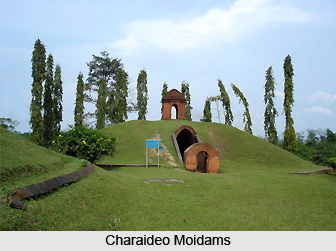 Tyao Khamti was an Ahom king who ruled the Ahom kingdom from 1380 CE to 1387 CE. The initiation of his reign put an end to the interregnum period in the kingdom which continued from 1376 CE to 1380 CE after the murder of Sutuphaa by Sutiya king. His victorious expedition against Sutiya king to avenge the death of his brother was exemplary of his courage and bravery.
Tyao Khamti was an Ahom king who ruled the Ahom kingdom from 1380 CE to 1387 CE. The initiation of his reign put an end to the interregnum period in the kingdom which continued from 1376 CE to 1380 CE after the murder of Sutuphaa by Sutiya king. His victorious expedition against Sutiya king to avenge the death of his brother was exemplary of his courage and bravery.
Coronation of Tyao Khamti
Among the sons of Ahom king Sukhaangphaa, Tyao Khamti was the third. When Sukhaangphaa died, his throne was initially succeeded by his two elder sons viz. Sukhrangphaa (1332 CE to 1364 CE) and Sutuphaa (1364 CE to 1376 CE). In 1376 CE, after the death of Sutuphaa, the nobles of the kingdom, led by the Borgohain and the Burhagohain, reached at the decision that none of the kings were able enough to become the king and rule the Ahom kingdom. In the following four years, from 1376 to 1380 CE, the kingdom had no king and Borgohain and Burhagohain. Later, when ruling the kingdom without a king became quite difficult, Tyao Khamti was coronated as the king in 1380 CE.
Expedition against Sutiya king
Sutuphaa, the elder brother of Tyao Khamti was murdered by Sutiya king. When Tyao Khamti succeeded the throne, in order to take revenge from the Sutiya King, he led a military expedition. In the expedition, Sutiya army was defeated and the nobles of the kingdom escaped and took refuge in the interiors of the hills.
Major Events in the Royal Family
There were two wives of Tyao Khamti out of which he was fond of the younger one. Before leaving for the expedition, he assigned the responsibility of the kingdom to his to his elder queen. At the time of the king`s departure the younger queen was pregnant. The elder queen had always been jealous of the younger queen as she was the king`s favourite and also because she was going to give birth to his first child, which would eventually heighten her position. Thus, taking the advantage of her position, the elder queen weaved a conspiracy against her and ordered her ministers to execute her as a punishment. However, considering her position, the ministers did not kill her and instead set her adrift on a raft in the Brahmaputra River. After floating for some time the raft landed in Habung village. In the village, a Brahman provided shelter to this unfortunate woman who died after giving birth to a boy. Before dying she revealed the true identity of the child to the Brahman who brought him up as his own child along with his other children. After spending the childhood in the Brahman family, the boy was later coronated as an Ahom king in 1397 CE. In the Ahom kingdom, he was named as Sudangphaa.
Assassination of Tyao Khamti
After achieving victory in the expedition against Sutiya king, when Tyao Khamti returned to his kingdom he was shocked to hear about the execution of his favourite queen. Another enquiry was set up regarding the issue which proved that the allegations against the younger queen were completely false. He was however highly influenced by the elder queen and thus could not take any action against her. Owing to this, he also failed to prevent her oppressive acts which greatly irritated the nobles. This finally resulted in the assassination of Tyao Khamti in 1389 CE by the nobles. Along with the king, the elder queen was also assassinated and was buried with the king in Charaideo. After his death, a period of interregnum followed which lasted up to 1397 CE. This interregnum ended with the succession of the throne by his son Sudangphaa.



















